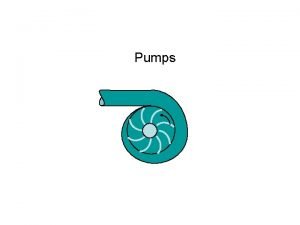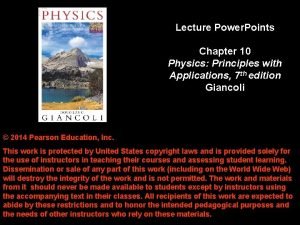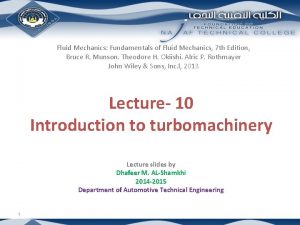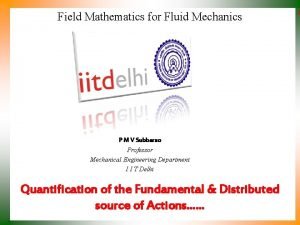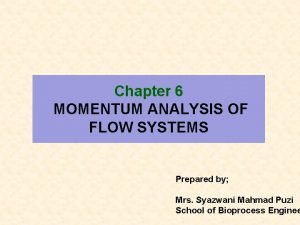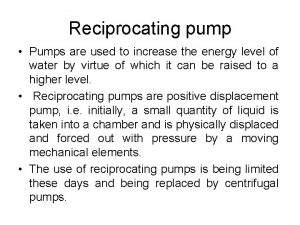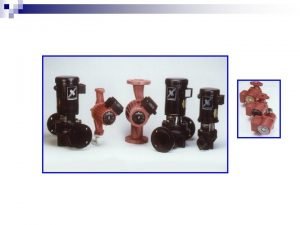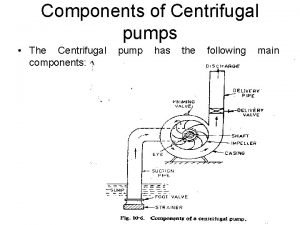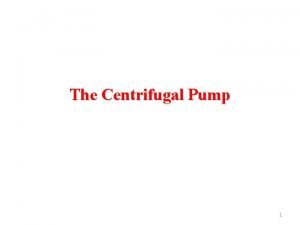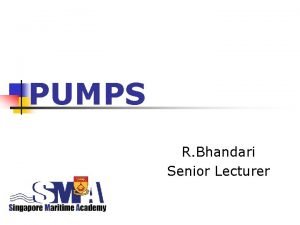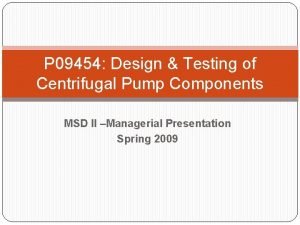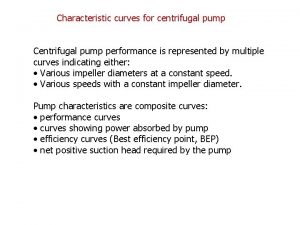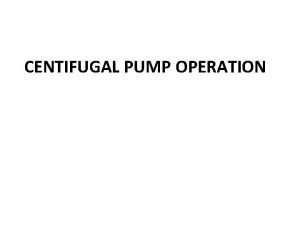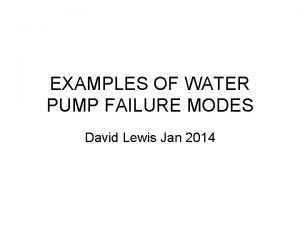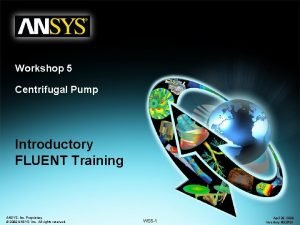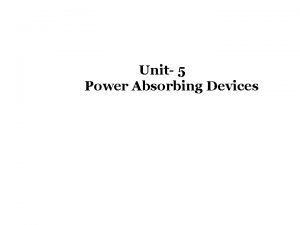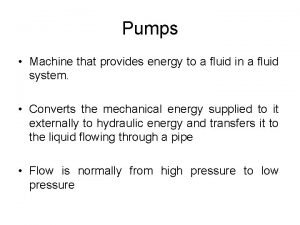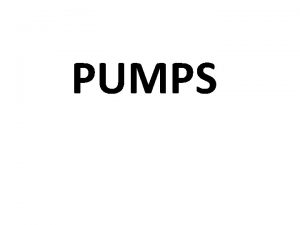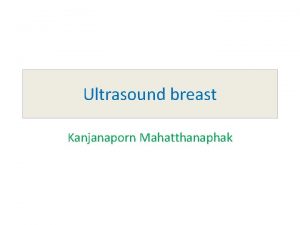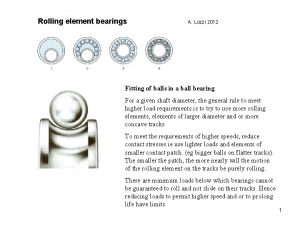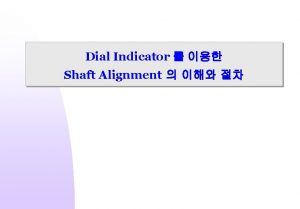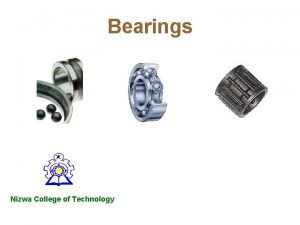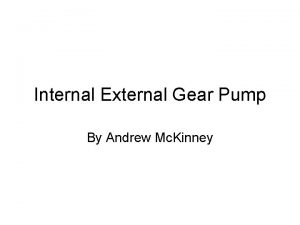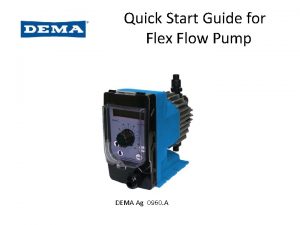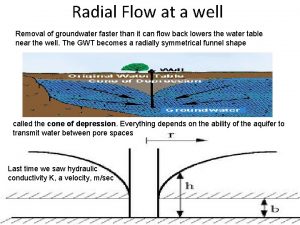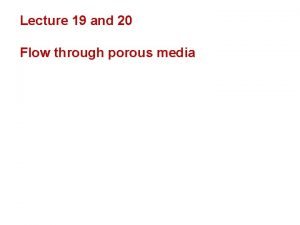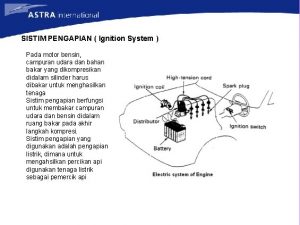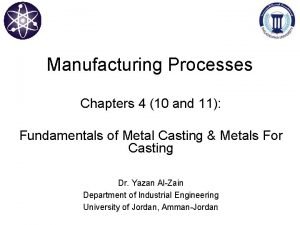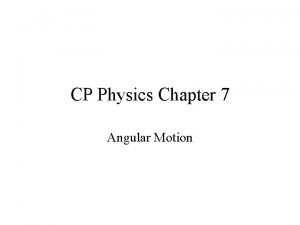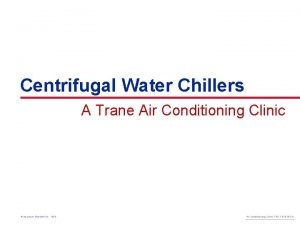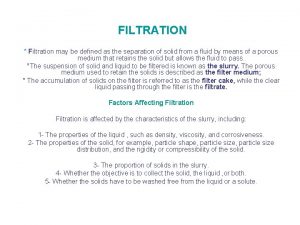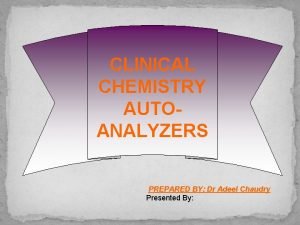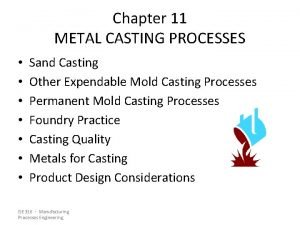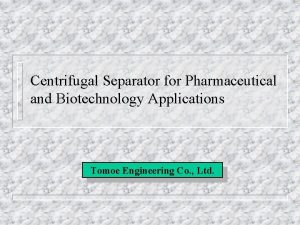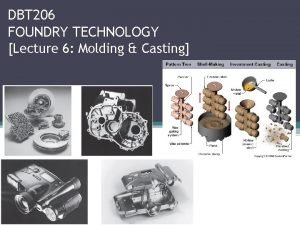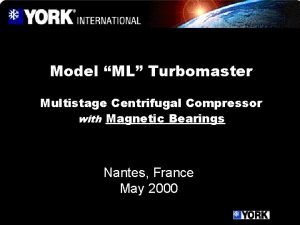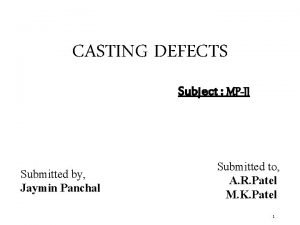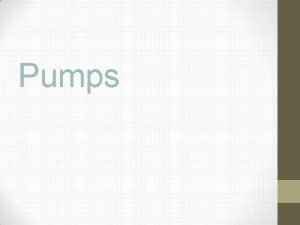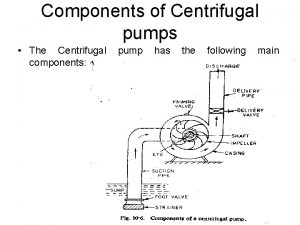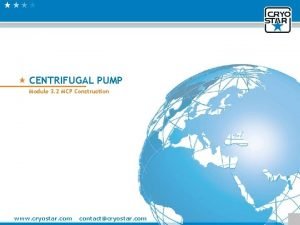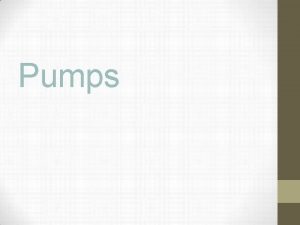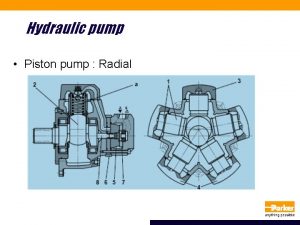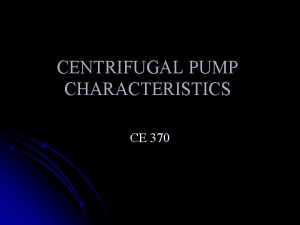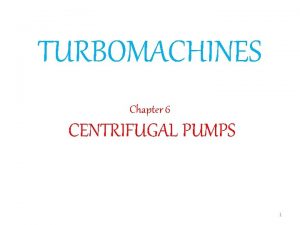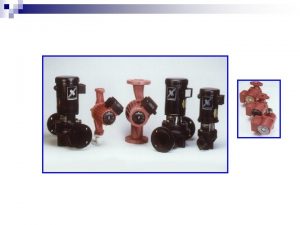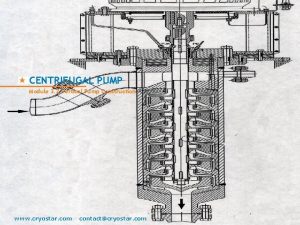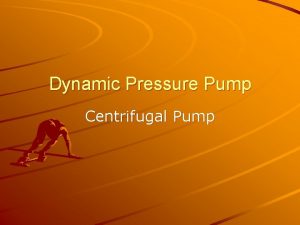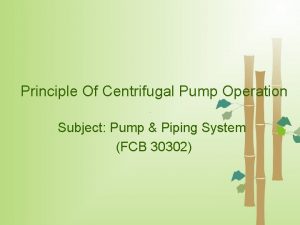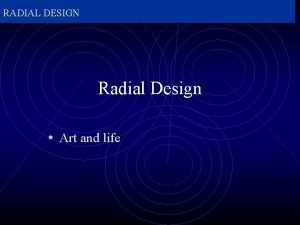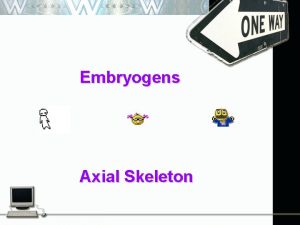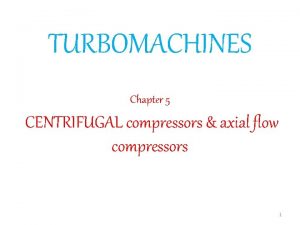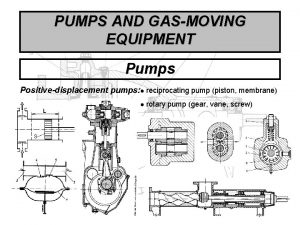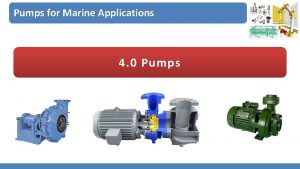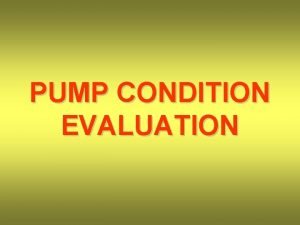Pumps Pump Types Centrifugal Pumps Radial Flow Axial


































































- Slides: 66

Pumps

Pump Types • Centrifugal Pumps – Radial Flow – Axial Flow – Mixed Flow • Positive Displacement Pumps – Piston – Cylinder

Radial Flow Pump High Head Low Flow

Axial Flow Pumps Low Head High Flow

Hydraulic Machinery Overview • • • Types of Pumps Dimensionless Parameters for Turbomachines Power requirements Head-discharge curves Pump Issues – Cavitation – NPSH – Priming • Pump selection

Pressure Developed by Centrifugal Pumps • Centrifugal pumps accelerate a liquid • The maximum velocity reached is the velocity of the periphery of the impeller • The kinetic energy is converted into potential energy as the fluid leaves the pump • The potential energy developed is approximately velocity head equal to the ____ at the periphery of the impeller • A given pump with a given impeller diameter and speed will raise a fluid to a certain height regardless of the fluid density

Radial Pumps centrifugal • also called _____ pumps • broad range of applicable flows and heads • higher heads can be achieved by increasing rotational speed diameter or the _______ ___ of the impeller Flow Expansion Discharge Casing Suction Eye Impeller Vanes

Axial Flow • also known as propeller _____ pumps • low head (less than 12 m) • high flows (above 20 L/s)

Dimensionless Parameters for Turbomachines • We would like to be able to compare pumps with similar geometry. Dimensional analysis to the rescue. . . • To use the laws of similitude to compare performance of two pumps we need – exact geometric similitude • all linear dimensions must be scaled identically • roughness must scale • homologous - streamlines are similar – constant ratio of dynamic pressures at corresponding points • also known as kinematic similitude same

Kinematic Similitude: Constant Force Ratio • Reynolds – ratio of inertial to viscous _______ forces • Froude gravity – ratio of inertial to ____ force • Weber surface-tension – ratio of inertial to ______ forces • Mach elastic forces – ratio of inertial to _______

Turbomachinery Parameters impeller rg e ha sc di hn e ug ro sh he ap ad e ss Where is the fluid? (Impeller is better defined)

Shape Factor • Related to the ratio of flow passage diameter to impeller diameter • Defined for the point of best efficiency • What determines the ideal shape for a pump? Exercise

* Impeller Geometry: Shape Factor Impeller diameter N 500 S 0. 18 1000 0. 37 radial 3400 1. 25 mixed 6400 2. 33 mixed 10000 *N 3. 67 in rpm, Q in gpm, H in ft pressure low ____ flow Radial: high _______, pressure flow axial: high _______, low _______ Nsp = 2732 S

Use of Shape Factor: Specific Speed • The maximum efficiencies for all pumps occurs when the Shape Factor is close to 1! – Flow passage dimension is close to impeller diameter! – Low expansion losses! • There must be an optimal shape factor given a discharge and a head. • Shape factor defined for specific cases – Double suction • Treat like two pumps in parallel – Multistage (pumps in series) • Use Q and H for each stage Why multistage?

Additional Dimensionless Parameters D is the _______ impeller diameter P is the power _____ Alternate equivalent way to calculate S. (defined at max efficiency)

Head-Discharge Curve • circulatory flow inability of finite number of blades to guide flow 2 V • friction - ____ • shock - incorrect angle of blade inlet ___ DV 2 • other losses – – bearing friction packing friction disk friction internal leakage Theoretical headdischarge curve circulatory flow k shoc friction Actual headdischarge curve sh oc k Q

Pump Power Requirements Water power Subscripts w = _______ water p = _______ pump s = _______ shaft m = motor _______

Power (% of design) Impeller Shape vs. Power Curves radial axial Discharge (% of design) http: //www. mcnallyinstitute. com/ S 1 - O. 33 2 - 0. 81 3 - 1. 5 4 - 2. 1 5 - 3. 4

Affinity Laws ä With diameter, D, held constant: • With speed, w, held constant: homologous held constant

Dimensionless Performance Curves 0. 08 He ad 0. 07 0. 06 0. 05 1 0. 9 0. 8 0. 7 0. 6 0. 5 0. 4 0. 3 0. 2 0. 1 0 y fi f E c n e ci 0. 04 0. 03 0. 02 D=0. 366 m 0. 01 0 0 0. 02 0. 04 0. 06 0. 08 Efficiency 0. 1 shape (defined at max efficiency) ä ä Curves for a particular pump Independent of the fluid! ______

Pump Example • Given a pump with shape factor of 4. 57, a diameter of 366 mm, a 2 -m head, a speed of 600 rpm, and dimensionless performance curves (previous slide). • What will the discharge be? • How large a motor will be needed if motor efficiency is 95%? Exercise

Pumps in Parallel or in Series • Parallel adds – Flow ____ same – Head ____ • Series – Flow ____ same – Head ____ adds • Multistage

Cavitation in Water Pumps • water vapor bubbles form when the pressure is less than the vapor pressure of water • very high pressures (800 MPa or 115, 000 psi) develop when the vapor bubbles collapse

Net Positive Suction Head • NPSHR - absolute pressure in excess of vapor pressure required at pump inlet to prevent cavitation – given by pump manufacturer – determined by the water velocity at the entrance to the pump impeller • NPSHA - pressure in excess of vapor pressure available at pump inlet – determined by pump installation (elevation above reservoir, frictional losses, water temperature) • If NPSHA is less than NPSHR cavitation will occur

Net Positive Suction Head 2 Dz Elevation datum Absolute pressure s = suction 1 Total head -pv! At cavitation! NPSHR increases with Q 2! How much total head in excess of vapor pressure is available?

NPSHA Subtract vapor pressure

NPSHr Illustrated Pv NPSHr Pressure in excess of vapor pressure required to prevent cavitation NPSHr can exceed atmospheric pressure!

NPSH problem Determine the minimum reservoir level relative to the pump centerline that will be acceptable. The NPSHr for the pump is 2. 5 m. Assume you have applied the energy equation and found a head loss of 0. 5 m. ? 18°C Exercise

Pumps in Pipe Systems Pipe diameter is 0. 4 m and friction factor is 0. 015. What is the pump discharge? 60 m 1 km m 11 m often expressed as

Pumps in Pipe Systems system operating point 120 Head (m) 100 e rv u c em 80 syst 60 40 Head vs. discharge pump curve for ____ Could you solve this with a dimensionless performance curve? Static head 20 0 0 0. 2 0. 4 0. 6 3 Discharge (m /s) 0. 8 What happens as the static head changes (a tank fills)?

Pump Selection • • Material Compatibility Solids Flow Head NPSHa Pump Selection software A finite number of pumps will come close to meeting the specifications!

Pump Selection Chart http: //www. pricepump. com/ Model M Model X

Selection of Pump Type Positive displacement Pumping head (m) 100 Radial Mixed 10 1 Axial 1 0. 0001 0. 1 Flow (m 3/s) 2 4 6 1 6000 4000 2000 1000 600 400 200 100 60 40 20 10 10 Power (k. W) 1000

End of Curve Operation • Right of the BEP (Best Efficiency Point) – is sufficient NPSH available for the pump to operate properly? – fluid velocities through the suction and discharge nozzles of the pump could be extremely high, resulting in increased pump and system noise (and wear) • Left of BEP operation – high thrust loads on the pump bearings and mechanical face seals result in premature failure. – The pump is oversized, resulting in lower efficiency and higher operating and capital costs.

Gould’s Pump Curves 890 rpm = 93. 2 rad/s Splitcase double suction BEP = 1836 L/s S=0. 787 Check the Power!

Shape Factor Solution • Create a dimensionless grouping mass Eliminate ______ length Eliminate _______ time Eliminate ______

Pump Curve Solution

NPSH solution ? 18°C


Pump System Terms – Static suction lift: Vertical distance from source water level to centerline of pump Gupta, Fig. 11. 17 b

Pump System Terms – Static discharge lift: Vertical distance from centerline of pump to water level at outlet Gupta, Fig. 11. 17 b

Pump System Terms – Total static head: Sum of static suction lift and static discharge lift =DZ Gupta, Fig. 11. 17 b

Example System-Head Curve Gupta, Fig. 11. 18

Pump Characteristics • So far, we’ve assumed the efficiency ( ) of a pump is constant • In practice, for a given pump running at a given speed, there are relationships among Q, Hp, and • The relationships are called the pump characteristics or performance curves

Pump Characteristics • The pump characteristic curves are experimentally derived • Generally shown as a function of Q – Pumping head (Hp) – Brake horsepower (P) – Efficiency ( )

Example Pump Characteristic Curve Gupta, Fig. 11. 19

Pump Systems • If we superimpose the system-head curve with the pump-characteristic curve, the intersection will determine the operating point of the pump in the system • If efficiency is too low, then select another pump

Elevated Section in a Pipe • Long pipelines laid to transport water from one reservoir to another over a large distance usually follow the natural contour of the land • Occasionally, a section of the pipeline may be raised to an elevation that is above the local HGL.

Elevated Section in a Pipe

Elevated Section in a Pipe • Conceptually, the vertical distance between HGL and EGL at any location is the velocity head, V 2/2 g. • And the vertical distance between HGL and the pipe line is the pressure head, P/γ. • In the vicinity of the pipeline summit, S, the pressure head may take on negative values. • This is because the total energy head must equal the vertical distance between the datum and the EGL

Elevated Section in a Pipe • Negative pressure exists in the pipeline where the pipeline is raised above the HGL. • In other word, it flows from a point of lower pressure toward a point of higher pressure. • This is possible because water always flows from high-energy toward low-energy locations.

Elevated Section in a Pipe • However, it is important to maintain gauge pressure at all points in a pipeline above the vapor pressure of water. • The vapor pressure of water is approximately equal to a negative water column of 10. 33 m at 20 o. C. • When the gauge pressure in a pipe drops below this value, water will be vaporized locally to form vapor pockets that separate the water in the pipe and will collapse in regions of higher pressure downstream.

Elevated Section in a Pipe • This action of vapor collapse is most violent, causing vibration and sound that can greatly damage the pipeline. • Water also contains dissolved gases that will come out from the water solution well before the vapor pressure point is reached. • So negative pressure should not be allowed to exceed approximately two-thirds of barometric head in any section of the pipe.

Numerical Example • A uniform steel pipeline 40 cm in diameter and 2000 m long carries water at 10 o. C between two reservoirs as shown in the figure below. • The two reservoirs have a water surface elevation difference of 30 m. At mid-length the pipeline must be raised to carry the water over a small hill. • Determine the maximum elevation to which the summit S may be raised above the lower reservoir water. Adapted from Fundamentals of Hydraulic Engineering Systems (Hwang and Hita, 1987)

Elevated Section in a Pipe A B

Numerical Example Solution • The total head loss between the two reservoirs is 30 m, which includes the entrance loss, he, the friction loss in the pipeline, hf, and the discharge loss, hd. • We may write the Bernoulli Equation between A and B: V is unknown: This is Type II design problem (discharge problem)

Numerical Example • assume f=0. 025 For commercial steel, e/D = 0. 00011, and Reynolds number is

Numerical Example • The Moody diagram gives f=0. 014, which is significantly different from the assumed value. The energy relationship must be rewriten as follows: Here, R=8. 76 x 105 and the Moody diagram gives f =0. 0138, which is close to the previous assumed value.

Numerical Example • The pressure is atmospheric at the downstream reservoir, and its water surface can be selected as the reference datum. • The velocity head at the reservoir can be neglected. • At 10 o. C the water vapor pressure head is -10. 2 m. • The energy equation between the summit point S and the lower reservoir may be expressed as: Maximum negative pressure head

Elevated Section in a Pipe

Numerical Example • The maximum elevation that the pipeline summit, S, may be raised, hs, is: In theory, if the summit is higher than 24. 9 m, we need a pump to help convey the liquid.

EGL and HGL of a Pumping Station • Pump operation adds energy to water in the pipeline by boosting the pressure head. • The pipeline can be separated into the suction pipe and the discharge pipe. • The suction side of the system from the supply reservoir to the inlet of the pump is subjected to negative pressure in energy equation.

EGL and HGL of a Pumping Station Adapted from Fundamentals of Hydraulic Engineering Systems (Hwang and Hita, 1987)

EGL and HGL of a Pumping Station • An energy equation can be written between the supply reservoir, S, and the receiving reservoir, R, as HS+HP = HR + hf+ h. L HP (or h. P or h) = H + hf+ h. L • Where HS and HR are the total energy in unit weight of water in the supply and receiving reservoirs, respectively. HP is the energy added by the pump. • Total Dynamic Head (TDH) = Elevation + Friction loss

Pump Curve http: //www. zoeller. com/Zep/Techbrief/JF 1 article. htm

NPSH • REQUIRED Net Positive Suction Head (NPSH) is a factor designed into a pump and measurable in the test laboratory. • It should be considered for providing sufficient pressure on the pump suction, at the impeller eye, to prevent "boiling". • All industrial pumps: http: //www. directindustry. com/ • Case of an industrial pump: http: //www. rothpump. com/chemical. htm
 Radial flow pumps
Radial flow pumps Radial flow centrifugal pump
Radial flow centrifugal pump Energy equation with pump
Energy equation with pump Radial flow centrifugal pump
Radial flow centrifugal pump Radial flow centrifugal pump
Radial flow centrifugal pump Discharge of double acting reciprocating pump
Discharge of double acting reciprocating pump Centrifugal pumps basics
Centrifugal pumps basics What are the components of centrifugal pump
What are the components of centrifugal pump Energy equation with pump
Energy equation with pump Centrifugal pump working principle
Centrifugal pump working principle Centrifugal pump testing
Centrifugal pump testing Affinity laws
Affinity laws Denis papin centrifugal pump
Denis papin centrifugal pump Suction lift
Suction lift Centrifugal pump failure modes
Centrifugal pump failure modes Centrifugal pump training
Centrifugal pump training Turbines are power absorbing devices
Turbines are power absorbing devices Classification of centrifugal pump
Classification of centrifugal pump Disadvantages of centrifugal pump
Disadvantages of centrifugal pump Vehicle mounted pump
Vehicle mounted pump Anti radial vs radial ultrasound
Anti radial vs radial ultrasound Axial and radial alignment formula
Axial and radial alignment formula Rim face alignment
Rim face alignment Taper roller bearing advantages and disadvantages
Taper roller bearing advantages and disadvantages External gear pump vs internal gear pump
External gear pump vs internal gear pump Internal gear pump advantages and disadvantages
Internal gear pump advantages and disadvantages Flex flow pumps
Flex flow pumps Types of centrifugal casting
Types of centrifugal casting Unconfined aquifer example problems
Unconfined aquifer example problems Darcy equation for radial flow
Darcy equation for radial flow Quattro flow pump
Quattro flow pump Is spinning a locomotor movement
Is spinning a locomotor movement Saginata
Saginata Fungsi dari centrifugal governor advancer adalah
Fungsi dari centrifugal governor advancer adalah Wallerstein model
Wallerstein model What is a centrifugal force in geography
What is a centrifugal force in geography Centrifugal casting formula
Centrifugal casting formula 9 kg
9 kg Trane air conditioning clinic
Trane air conditioning clinic Kelebihan dan kekurangan centrifuge
Kelebihan dan kekurangan centrifuge Dslingshot
Dslingshot Permanent mold casting advantages and disadvantages
Permanent mold casting advantages and disadvantages Centrifugal force ap human geography
Centrifugal force ap human geography Pressure filter advantages and disadvantages
Pressure filter advantages and disadvantages Centrifugal analyzer principle
Centrifugal analyzer principle Centrifugal casting process steps
Centrifugal casting process steps Pharmaceutical centrifugal separator
Pharmaceutical centrifugal separator Zinc sulphate centrifugal flotation technique
Zinc sulphate centrifugal flotation technique Szivattyú fajták
Szivattyú fajták Expendable casting
Expendable casting Centripetal movement geography
Centripetal movement geography Compact state geography definition
Compact state geography definition Centrifugal compressor
Centrifugal compressor Héjformázás
Héjformázás Arise precision casting
Arise precision casting Air to oxygen ratio chart
Air to oxygen ratio chart Simple mask flow rate
Simple mask flow rate Venturi mask oxygen flow rate
Venturi mask oxygen flow rate Laminar vs turbulent flow
Laminar vs turbulent flow Internal flow vs external flow
Internal flow vs external flow Ecological succession
Ecological succession Oikos meaning
Oikos meaning Structure chart in software engineering
Structure chart in software engineering Data flow structure
Data flow structure Rotational and irrotational flow
Rotational and irrotational flow Internal and external flow
Internal and external flow Data flow vs control flow
Data flow vs control flow
